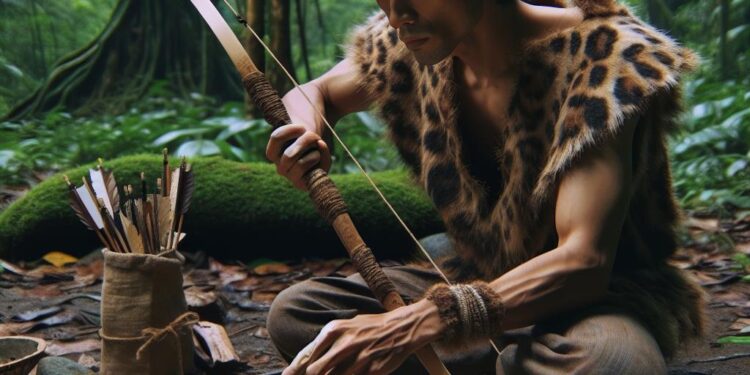Understanding the art of creating primitive hunting tools isn’t just for history buffs or survivalists. In emergencies or off-grid scenarios, knowing how to make tools can mean the difference between thriving and struggling. Recognising how to fashion simple yet effective tools from natural resources is invaluable when modern conveniences aren’t available. However, many often overlook the critical skills needed to successfully craft these tools, like selecting the right materials or understanding the tools’ mechanics. This blog will provide you with practical advice, guiding you through making effective survival tools while helping you avoid common mistakes. Let’s delve into this essential skillset!
What Are Primitive Hunting Tools and How to Craft Them?
Primitive hunting tools are the epitome of simplicity and ingenuity; they’re the go-to for anyone wanting to venture into survival, emergency prep, or off-grid living. Imagine being out in the wild, relying not on fancy gadgets, but your own hands and creativity. These tools—like bows, arrows, and slingshots—have been the backbone of human survival for millennia. Crafting them isn’t just an exercise in resourcefulness; it’s about connecting with our ancient roots and learning to rely on nature’s bounty. Picture yourself finding a sturdy branch and some cordage to create a bow, or shaping stones into sharp arrowheads. It’s not just about having tools; it’s about the satisfaction of knowing you can provide for yourself with what’s around you. In the world of survival, these primitive tools are not only practical and reliable—they’re a testament to human resilience and adaptability.The Importance of Primitive Hunting Tools
Knowledge of primitive hunting tools can significantly enhance your wilderness survival skills and self-reliance, offering a range of practical improvements to boost your outdoor experiences. Here’s how they make a difference:- Enhanced Survival Readiness: Understanding how to craft and use primitive hunting tools prepares you for any unexpected situations where modern gear might not be available, ensuring you’re ready to tackle whatever nature throws at you.
- Increased Self-Sufficiency: By crafting tools from natural resources, you reduce reliance on modern systems, promoting self-sufficiency and a sense of empowerment in your survival journey.
- Improved Safety: Knowing how to use these tools for hunting or protection enhances your ability to safeguard yourself and others in dangerous or threatening situations in the wild.
- Efficient Gear Use: Developing these skills helps you utilise available materials efficiently, turning potential waste into functional tools, which is crucial in resource-scarce environments.
- Health Benefits During Emergencies: Crafting lightweight, primitive gear can assist in managing your energy expenditure, helping you conserve strength crucial for survival.
- Connection with Nature: Using native materials fosters a deeper connection to nature, enriching your wilderness living experience and broadening your understanding of the natural world.
- Cost-Effectiveness: By learning these skills, you can save on expensive modern equipment, which can often be bulky and cumbersome. Primitive tools can be as effective and are often easier to replace or repair.
Master Daily Survival with Ancient Hunting Skills
- Start small! Add simple tools like a slingshot or a spear to your survival kit for practice on backyard targets or local wildlife control, even in urban gardens.
- Check out local woods for whittling sticks into hunting tools during hikes. It’s like returning to ancient craft, perfect for weekends and rural camping trips.
- Organise gatherings with pals to learn and share tool-making skills, creating a community of like-minded survivalists, no matter your town’s size.
- Set up a space at home, be it a garage or a corner by the apartment window, to experiment with knots and materials found in ‘Primitive Hunting Tools’. Spoiler: it’s an indoor activity that doesn’t bug apartment neighbours!
- Incorporate tool maintenance into your routine, just like cleaning your kitchen, ensuring longevity and preparedness when you next escape the daily hustle for an outdoor adventure.
DIY Tips & Guided Use for Primitive Hunting Tools
- Start with a basic sling. Collect a few sturdy branches, some string, and small stones. Practice throwing for accuracy in your garden before taking it out into the wild.
- Craft a simple spear with a straight stick and sharpened stone. Great for fishing or small game hunting, especially useful for campers who may need to catch their dinner.
- Try making a bola from entwined rope and knots; this tool is useful for solo travellers looking to hunt small animals efficiently.
- For remote workers, creating a basic bow and arrow is effective but can take time, so consider joining a survival course to speed up your learning process.
- Always seek expert guidance or pro gear for large game or in treacherous terrains; safety should never be compromised.
Budgeting Your Time and Money for Hunting Tools
Let’s explore the cost and time commitments involved in mastering the art of crafting your own primitive hunting tools.| Primitive Hunting Tool | Cost | Time & Effort |
|---|---|---|
| Bow and Arrow | Low (materials gathered from nature) | High (requires significant time to carve and shape) |
| Sling | Low (natural materials like leather or cloth strips) | Medium (easy to make once materials are gathered) |
| Atlatl | Low (wood and natural fibers) | High (crafting and practice needed for accuracy) |
| Traps and Snares | None | Medium (setting up takes some skill and knowledge) |
| Throwing Stick | None | Low (simple to make and use) |



